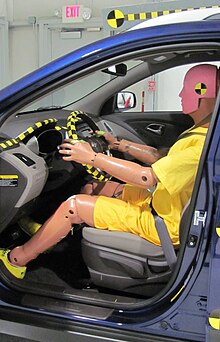Для работы проектов iXBT.com нужны файлы cookie и сервисы аналитики.
Продолжая посещать сайты проектов вы соглашаетесь с нашей
Политикой в отношении файлов cookie
Широкой публике известно, что службы,
механизмы и системы, которые призваны НЕ довести дело до ДТП, входят в пул
активной безопасности; минимизацией последствий УЖЕ СЛУЧИВШЕГОСЯ дорожно-транспортного
происшествия занимаются системы, устройства и приборы, которые относят к
пассивной безопасности. А вот дальше вашему вниманию информация, которая не так
хорошо известна «широкой автомобильной общественности».

Совокупность всех конструктивных
свойств автомобиля, которые направлены на предотвращение ДТП (вплоть до исключения
его предпосылок), укладывается в следующий список:
-
Антиблокировочная система тормозов (ABS или АБС) в
сотые доли секунды затормаживает и растормаживает тормоза, а некоторые
системы делают это даже до тысячи раз в секунду. И там, где имеется хоть
какая-то сцепка колеса с дорожным покрытием, происходит замедление
автомобиля. А там, где колесо скользит, происходит «роспуск» тормозной
системы, и автомобиль получает возможность управления. Система эта была
придумана «для чайников», то есть для массового потребителя и требует
следующего алгоритма действий — педаль тормоза резко в пол, и рулевым
колесом «уворачивайся» от надвигающихся препятствий. Этому приему вождения
учат специально на курсах контраварийной подготовки, а в качестве примечания замечу, что
профессиональные водители, в том числе и автомобильные спортсмены, систему
АБС и вообще подобных электронных ассистентов «не сильно жалуют»,
предпочитая иметь собственный ежесекундный
контроль над автомобилем. -
Система курсовой устойчивости работает «в связке» с АБС
и притормаживает одно из четырех колес в случае потери автомобилем
заданной траектории движения. Эту систему «продвинутые» водители также не очень
любят, поскольку она не дает направить машину в контролируемое скольжение. -
Система распределения тормозных усилий (на самом-то
деле) применялась еще на древних Жигулях и Москвичах, но там «работало»
механическое приспособление, а на современных авто этим занимается один из
электронных блоков управления (ЭБУ). Масса датчиков ежесекундно передает
ему свои показания — о скорости автомобиля, о положительном или
отрицательном его ускорении, об угловой скорости (если возникает хоть
капля подозрения на вращение автомобиля вокруг вертикальной оси) и т. д. и
тп. Этот массив данных обрабатывается в считанные миллисекунды, и
соответствующие команды направляются исполнительным механизмам. -
Система экстренного торможения работает (через ЭБУ) по
такой же схеме и в этой же связке со всеми остальными электронными системами,
но отдельно также отслеживает ещё и скорость перемещения педали тормоза. В
случае распознавания панических действий водителя она автоматически
поднимает давление в системе, помогая водителю, и включает аварийку на три
моргания для информирования задних. -
Электронная блокировка дифференциала в основном
применяется в тяжелых и полноприводных автомобилях (паркетниках), а также
в спортивных версиях «дорожных гражданских» авто — «для полноты ощущения
драйва и контроля над автомобилем». -
Противобуксовочная система, понятно, помогает тронуться
без срыва ведущих колес, но лишает «возможности» стартовать с форсом и
визгом колёс. -
Внешние световые приборы не только помогают безопасно
управлять автомобилем в условиях недостаточной видимости, но и другим
участникам дорожного движения обозначают наше транспортное средство на
дороге.
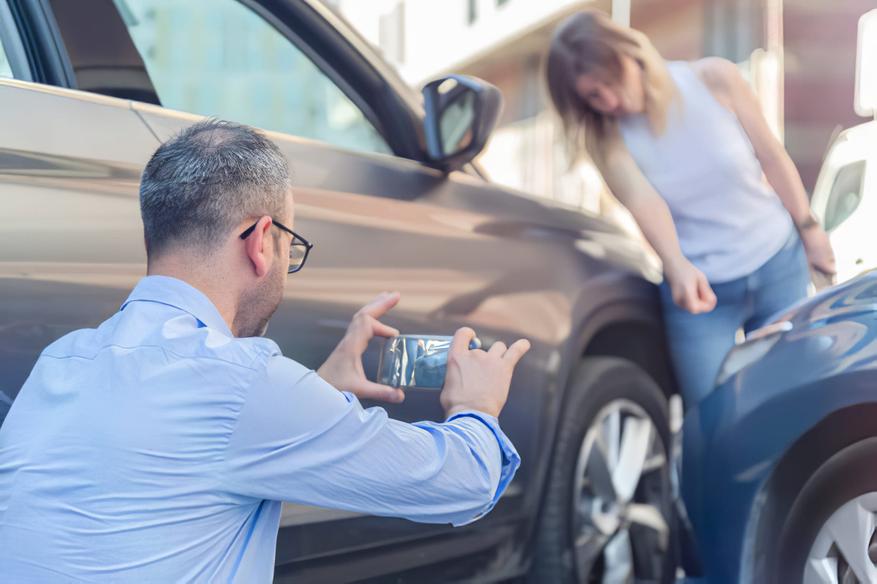
Спецы по безопасности отдельно выделяют
еще и так называемые вспомогательные системы (ассистенты), которые также
предназначены облегчать жизнь водителя:
-
Электромеханический стояночный тормоз «облегчает»
жизнь иным ленивым автовладельцам, автоматически фиксируя автомобиль при
его полной остановке, и
автоматически же снимая его с ручника, когда нога водителя касается педали
акселератора. -
Парктроник, понятно, помогает не помять-поцарапать
соседей по парковке. -
Адаптивный круиз-контроль мониторит скорость дорожного
потока и расстояние до впереди идущего автомобиля, прибавляя или снижая
скорость своего собственного авто сообразно скорости соседей по потоку. -
Система помощи при трогании на подъём избавляет от
нервного и физического напряжения не только начинающих, но и опытных
водителей, действительно весьма полезная штука. -
Система помощи при спуске с горы не позволяет сорваться
автомобилю в юз на скользком (грязном) покрытии. -
Система обнаружения помехи в «слепых зонах» позволяет
обнаружить соседей по потоку справа-сзади и/или слева-сзади.
Некоторые авторы, пишущие на темы
безопасности, относят в «активную» часть даже такие вещи, например, как и системы
навигации, в том числе и ЭРА-ГЛОНАСС, а также — «климатическую обстановку» в
салоне или громкость музыки, словом, всё то, что влияет на физическое,
эмоциональное и психическое состояние человека за рулём.
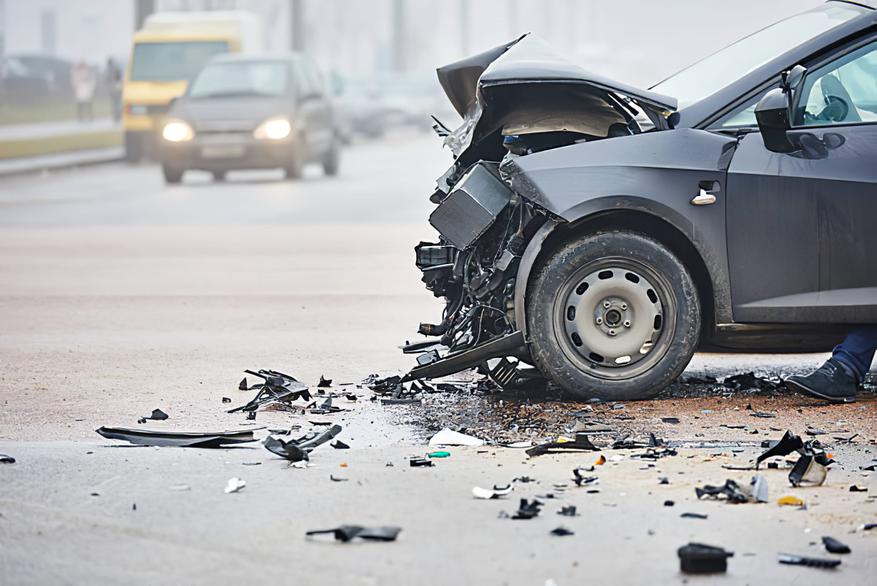
Список конструктивных элементов автомобиля,
которые направлены на минимизацию тяжести ДТП, сохранения жизни и здоровья
своих седоков, также не мал. Большинство из них срабатывает в момент
столкновения и «продолжает работать» до полной неподвижности транспортного
средства.
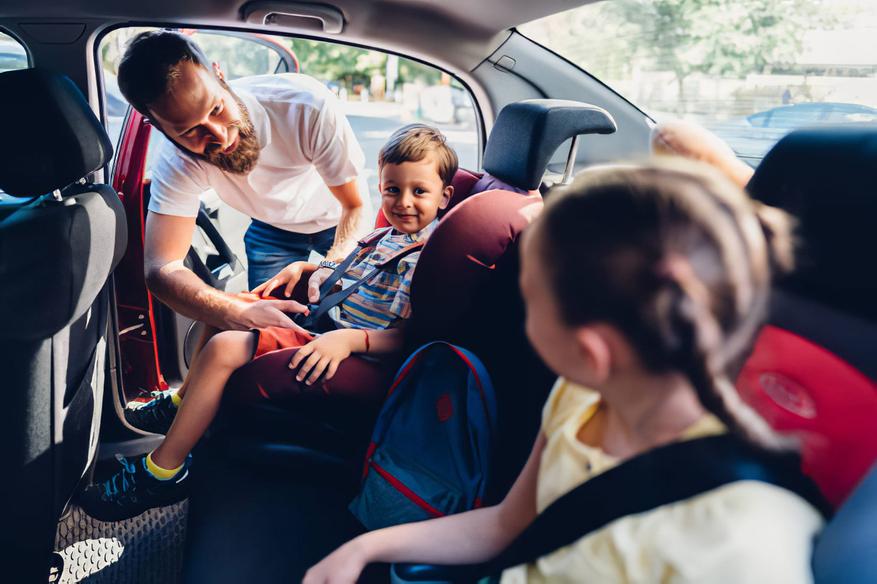
Включает в себя такие конструктивные
элементы:
-
Высокопрочная клетка непосредственно пассажирского салона
защищает седоков при столкновении (во всех спортивных автомобилях это архи
важная конструктивная позиция). -
Энергопоглощающие кузовные элементы, которые
«сламываются» и складываются в программируемом «формате», имеются в
передней и задней частях кузова вне салона и призваны выполнять функции
гашения отрицательного ускорения автомобиля при ударе. -
Защита от проникновения силовой установки (двигателя и КПП),
а также других агрегатов трансмиссии и ходовой части в салон и увод их под
днище автомобиля. -
Годами (и даже десятилетиями) сложившаяся практика
проектирования днища автомобиля, состоящего сегодня из металлических
конструкций самых разных форм, сечений и профилей; тут тебе и жесткость на
кручение, и шумоизоляция, и пассивная безопасность авто. -
Мягкие, зачастую пластиковые, бамперы не только
защищают несущие части кузова при ударе на «пешеходных» скоростях, но
также выполняют задачи гашения инерции и при более сильном ударе. -
Среди так называемых удерживающих систем первыми
выделяют, разумеется, ремни безопасности, а также «сопутствующие» им
элементы — пиропатроны, преднатяжители и т. д. -
Широкие дверные пороги и поперечные брусья безопасности
в дверях проектируют для защиты от бокового удара. -
Подушки безопасности раскрываются в течение 300-400
миллисекунд, вне зависимости от того — это фронтальные, боковые, встроенные
в ремни безопасности или в надкапотное пространство для защиты пешеходов. -
Из наиболее «древних» приспособлений, которые начинали
применяться еще на автомобилях 50-60-х годов прошлого столетия (и
применяются до сих пор) — это складывающиеся рулевые колонки, травмобезопасные
педальные узлы, где при резко неадекватном «нажатии» педали отламываются с
мест креплений, уменьшая риск повреждения ступней водителя. -
Активные подголовники пассажирских сидений
сегодня защищают шейные позвонки седоков от так называемой хлыстовой
травмы при ударе сзади. -
Сминаемые и/или мягкие элементы внутренней отделки интерьеров
также минимизируют травмы, если не сработали или не справились подушки. -
Современные многослойные поликарбонатные стекла окон «по
кругу», которые при разрушении не травмируют пассажиров. -
Системы Эра-Глонасс и подобные им, которые оповещают
экстренные службы о факте происшествия.
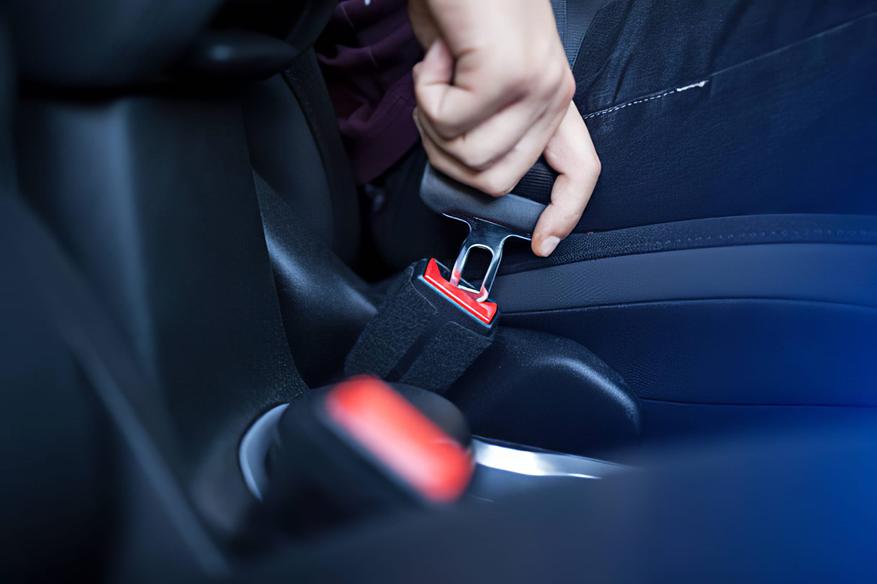
На подавляющем большинстве проданных
автомобилей системы пассивной безопасности, как правило (и к великому счастью),
остаются невостребованными в течение всего срока жизни автомобиля. Однако при покупке
нового авто экономить на комплектациях не стоит, а при покупке
подержанного — нужно трижды перепроверить сроки годности и функционал всего
установленного здесь оборудования.
Оно может сработать всего один лишь раз,
зато спасет вашу жизнь.
Будьте разумными, и берегите себя! На этом всё. Для тех кто в поисках подарков на Новый Год, рекомендую посмотреть обзоры полезных устройств для дома и семьи:
— Недорогой кухонный помощник. Обзор погружного блендера Scarlett SC-HB42F84;
— Обзор умных напольных весов Tefal Goodvibes Life BM9600S1 с разными показателями тела и красивым дизайном.
Сейчас на главной
Новости
Публикации

На протяжении длительного времени я пользовался Oppo Reno 10 и постепенно осознал, насколько малы, а во многом и вовсе незначительны, различия между этой моделью и Pro. И в конце концов, такие…

Если Ваш послушный и умный помощник вдруг стал капризничать, недовольно «пищать», тыкаться в стены и упорно отказывается ночевать в «собственном доме», гаджет зовёт владельца на помощь. Специалисты…

На сегодняшний день производители
проекторов привлекают внимание к своему продукту с помощью высоких показателей
яркости, контрастности, оптического увеличения и разрешения. Однако есть
области,…

В конце ноября Компания Дарк Проджект открыла
предзаказ на новую беспроводную
гарнитуру Дарк Проджект HS5. Новинка сразу вызвала бурный ажиотаж, а
скорость, с которой она была раскуплена, говорит о…

Подходит к концу 2023 год, и, пожалуй, пора начинать подводить его итоги. Например — следите ли вы за интересными фэнтези-циклами? Мы, разумеется, да. В 2023 году было выпущено…
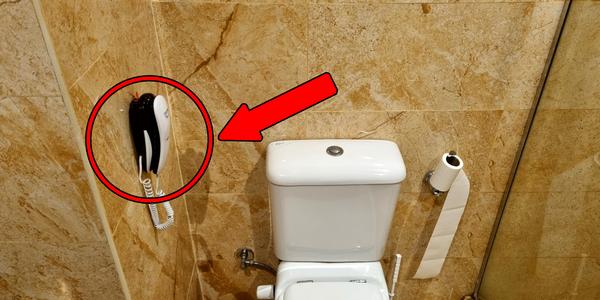
Недавно отдыхал в Хургаде, где впервые и обратил внимание на наличие телефона в туалетной комнате своего гостиничного номера. Во всяком случае, в Тайланде и Вьетнаме сего девайса у меня точно не…
Автомобильная безопасность условно делится на два вида — активную и пассивную. Активная безопасность — это системы и устройства машины, которые позволяют ей избежать столкновения. А пассивная — это возможности автомобиля сохранить жизнь и здоровье пассажиров, если нештатная ситуация всё-таки произошла. В арсенале любого современного авто есть целый ряд средств для смягчения последствий аварии: ремни, подушки, деформируемые зоны.
Что случается с автомобилем и его пассажирами при лобовом ударе? Автомобиль мнётся и останавливается, а пассажиры по инерции продолжают «лететь» вперёд, навстречу рулю, торпеде и лобовому стеклу. Казалось бы, места в салоне машины немного, сильно разогнаться (и, значит, стукнуться) не получится. Если бы. Ведь ускорение достигает десятков g, и такой удар может быть равносилен прыжку с многоэтажки.
Чтобы живые остались в живых и не покалечились во время серьёзной аварии, их скорость при столкновении нужно погасить как можно плавнее (недаром, прыгающим с высоты подстилают многоярусные маты). Причём скорость гасить нужно так, чтобы внутри автомобиля оставалось достаточно жизненного пространства. А вот это уже задача, которая предъявляет к силовой структуре автомобиля взаимоисключающие требования.
Получается, что кузов должен быть и жёстким, и податливым одновременно. Так вот, жёстким делают каркас «жилой» зоны, в которой находятся водитель и пассажиры — при ударе она деформируется в последнюю очередь. Силовая «клетка» салона сделана из сверхпрочной стали, в дверях есть мощные брусья, не дающие им сминаться. А относительно податливыми изготавливают специальные зоны, за счёт деформации которых и будет гаситься скорость. Моторный отсек и багажник как раз являются так называемыми зонами запрограммированной деформации. Так автомобили делают сравнительно недавно. Раньше же никто об этом не задумывался, и машины сминались равномерно — страдал и кузов, и салон. А у современных автомобилей, попавших в аварию, как правило, можно увидеть, что передок разбит всмятку, а салон цел.
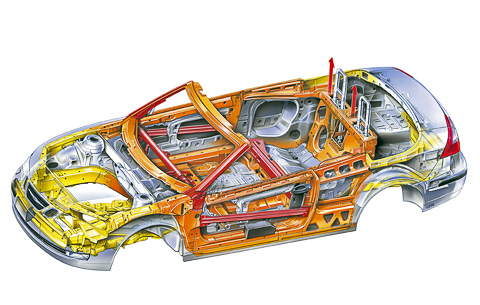
Кузов автомобиля разрабатывается таким образом, чтобы при ударе передняя и задняя части, сминаясь, гасили энергию удара, а жёсткая «клетка» салона оставалась невредимой.
Кстати, большую проблему при лобовом столкновении может представлять двигатель. Поэтому, чтобы при столкновении он не влетал в салон (что не сулит ничего хорошего), его опоры и моторный щит делают так, чтобы он смещался как можно ниже или вообще выпадал вниз, не нанося салону никакого вреда.
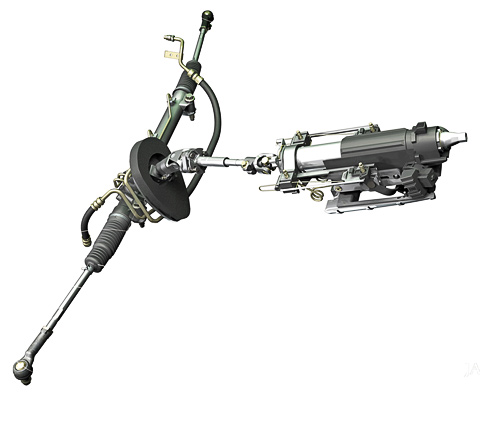
При ударе важно, как поведут себя окружающие водителя части машины. Травмобезопасная энергопоглощающая складывающаяся рулевая колонка и ломающийся кронштейн педального узла сохранили немало рук и ног.
Не менее страшен и удар сзади. В этом случае у пассажиров есть опасность повреждения шеи. Чтобы этого избежать, человечество придумало подголовники, а затем — и активные подголовники. Первые просто удерживают голову, не давая ей слишком сильно запрокинуться назад. А вторые сами, как только произошла авария, «прыгают» вперёд, обеспечивая мгновенную опору голове и вообще не давая ей смещаться.
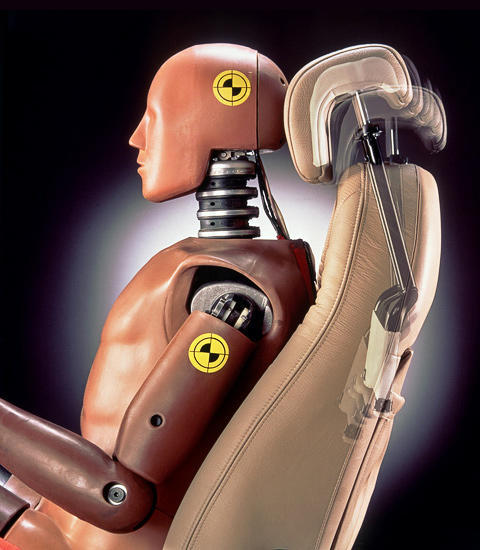
Активные подголовники защищают шею при ударе сзади.
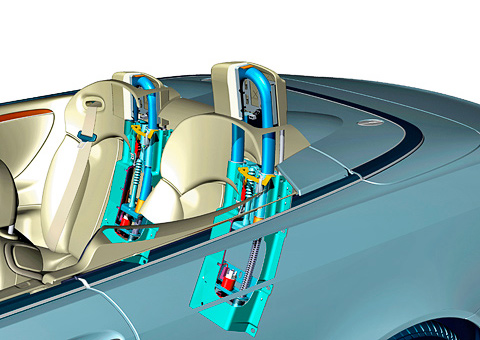
Выстреливающие дуги в кабриолетах. Здесь первопроходцем стал Mercedes-Benz. Именно он впервые применил поднимающуюся при опрокидывании дугу для защиты пассажиров. Saab и ряд других производителей подхватили эту идею.
Но это полдела. Чтобы люди получили наименьшие увечья, их во время аварии нужно удерживать совершенно особым способом.
Способы нам всем известны с пелёнок, но менее значимыми от этого они не становятся. Это устройства, системы и конструкции, которые преследуют всего лишь одну цель — вовремя «поймать» человека и как можно бережнее и плавнее погасить его скорость. Конечно, лучше остальных на этом поприще себя проявил бы большой батут. Он способен наиболее безвредно погасить энергию и скорость падающего на него предмета. Ведь он мягкий. Жаль, что места для батутов и многоярусных матов в автомобиле нет. Зато нашлось место для ремней и подушек безопасности.
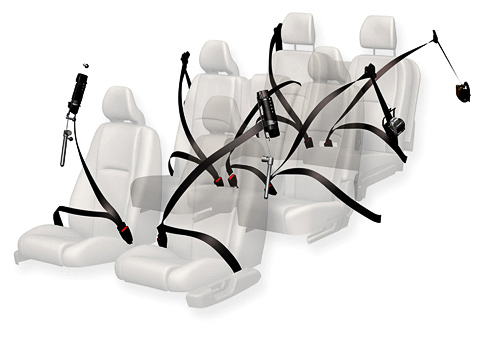
Ремень безопасно гасит удар, поскольку площадь его взаимодействия с телом относительно велика и удерживает человека на месте, не давая ему удариться и вылететь из салона.
Ремни перекочевали в автомобиль, как и множество других полезных решений, из авиации. Поначалу на автомобили ставились ремни с двухточечным креплением, которые «держали» седоков за живот или грудь. Не прошло и полувека, как инженеры смекнули, что многоточечная конструкция гораздо лучше, потому что при аварии позволяет распределить давление ремня на поверхность тела более равномерно и значительно снизить риск травмирования позвоночника и внутренних органов. В автоспорте, например, применяются четырёх-, пяти- и даже шеститочечные ремни безопасности — они держат человека в кресле «намертво». Но на «гражданке» из-за своей простоты и удобства прижились трёхточечные.
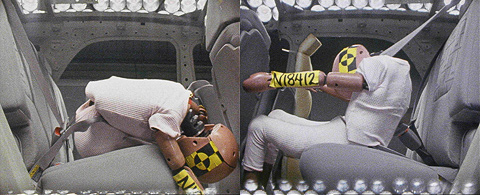
Как говорится, почувствуйте разницу. Ремень с двухточечным креплением (слева) более травмоопасен для органов брюшной полости и позвоночника.
Чтобы ремень нормально отработал своё предназначение, он должен плотно прилегать к телу. Раньше ремни приходилось регулировать, подгонять по фигуре. С появлением инерционных ремней необходимость «ручной регулировки» отпала — в нормальном состоянии катушка свободно крутится, и ремень может обхватить пассажира любой комплекции, он не сковывает действия и каждый раз, когда пассажир захочет сменить положение тела, ремешок всегда плотно прилегает к телу. Но в тот момент, когда наступит «форс-мажор» — инерционная катушка тут же зафиксирует ремень. Кроме того, на современных машинах в ремнях применяются пиропатроны. Небольшие заряды взрывчатки детонируют, дёргают ремень, и тот прижимает пассажира к спинке кресла, не давая ему удариться.
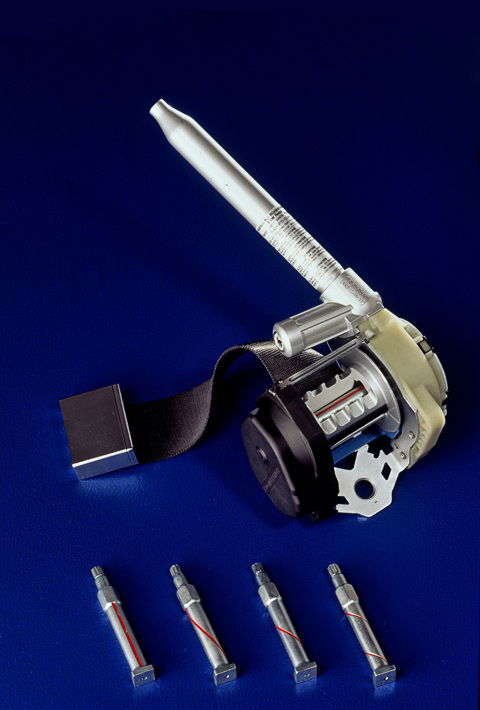
Преднатяжители значительно повышают эффективность пристёгивания. С их помощью ремень плотно прижимает седока к спинке кресла, независимо от того, в какой позе находится последний. Пиротехнические преднатяжители срабатывают только во время столкновения по команде датчика удара; электрические работают на опережение и натягивают ремень в тот момент, когда электроника зафиксируют критические ускорения, например, при заносе или экстренном торможении.
Ремни безопасности — это одно из самых действенных средств защиты при аварии. И хотя им сто лет в обед, их конструкция постоянно изменяется и улучшается. Вторым по значимости после ремней изобретением можно, пожалуй, назвать подушки безопасности.

Ford и Volvo, возможно, начнут устанавливать на серийные машины четырёхточечные ремни.
Прообраз современной подушки был запатентован ещё в 1953 году. Нужно ли говорить, что на тот момент идея надувать сложенные мешки во время аварии была более чем смелой? Самые дерзкие из разработчиков ухватились за неё, но потерпели фиаско — необходимых технологий для реализации на тот момент просто не было.
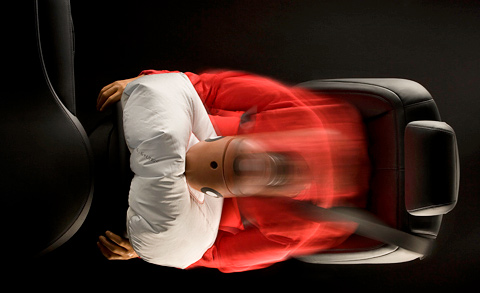
Работа подушки безопасности без ремня, как и ремня без подушки, — эффективна только наполовину. Эти средства друг друга дополняют, но взаимозаменяемыми быть не могут.
Изначально вариантов наполнения колокола подушки было несколько. Например, некоторые инженеры предлагали закачивать в колокол газ, который хранился бы под высоким давлением в баллоне. Но принцип пиротехнического наполнения подушки перевесил. Именно он позволил надувать её мгновенно — всего за 30—50 тысячных доли секунды. И пока инженеры нашли необходимое горючее, которое при небольших размерах заряда срабатывало как надо, они многое перепробовали, в том числе и ракетное топливо. Сегодня в подушках в качестве пиропатрона используются компактные и лёгкие «таблетки» из кристаллического вещества — азида натрия (NaN3). Если соединение при помощи электрического тока нагреть до температуры выше 330°C, оно начнёт разлагаться на азот и натрий со скоростью, которая позволяет наполнять колокол подушки и доводить давление газов в нём до рабочей величины всего за 0,025–0,05 секунды.
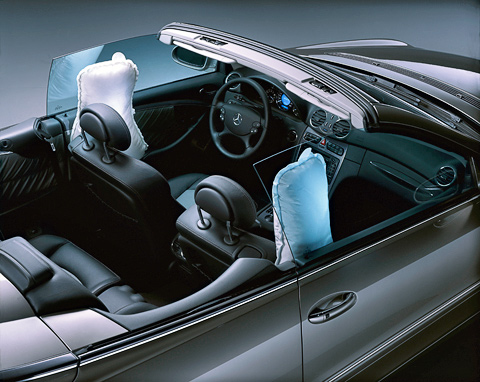
Особые требования к боковым подушкам предъявляются на открытых автомобилях. Отсутствие жёсткой крыши и стоек заставляет монтировать их в верхней части дверей и делать более прочными.
Срабатывание подушки опасно резким скачком давления, который может привести к травмированию барабанных перепонок и контузии. Ведь раскрытие колокола (иногда одновременно нескольких) происходит в небольшом замкнутом пространстве автомобильного салона. Подходов к решению этой проблемы несколько. Например, скорость вылета подушки снижают до определённого предела, чтобы хоть какая-то часть вытесняемого воздуха смогла стравиться через неплотности салона. Второй, достаточно действенный способ, — применение подушек относительно небольшого объёма. Но в некоторых случаях проблем с барабанными перепонками и контузией не избежать, всё зависит от индивидуальных особенностей человека и размера машины.
Первые подушки, кстати, появились не на машинах Mercedes-Benz, как считают многие, а на «американцах». В середине 70-х годов концерны Ford и General Motors построили более 12 тысяч машин, оборудованных эйр-бэгами. Причём тогда американцы делали подушки, которые заменяли ремни безопасности. Но подушка, раскрываясь, «летит» навстречу человеку со скоростью 270—300 км/ч… И если он не пристёгнут, вред она может причинить просто огромный. Не раз фиксировались случаи перелома шейных позвонков, причиной которых была именно подушка безопасности. Вот и отказались американцы от подушек-заменителей ремней безопасности.
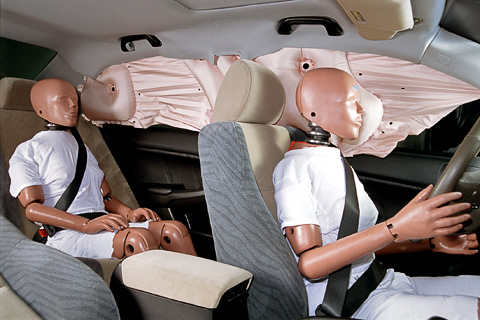
Возродили подушки безопасности инженеры отдела пассивной безопасности Mercedes-Benz. И надо сказать, они, не без участия специалистов компании Bosch, одни из первых довели подушки до ума. Путь был сложен и тернист, но именно Mercedes-Benz в 1980 году поставил подушки безопасности на поток и стал оснащать ими свой S-класс. Они поняли, что подушки надо делать так, чтобы они работали в паре с ремнями безопасности, а не заменяли их. И тогда всё стало на свои места, подушки начали работать с поразительной эффективностью. Кстати, до сих пор во многих автомобилях, если человек не пристёгнут, подушки безопасности просто не сработают — опасно!
Несмотря на большой прорыв в сфере «надувной» защиты, сказать, что подушки находятся на пике развития нельзя. В скором времени подушки наделят способностью раскрываться не после аварии, а за мгновения до нее, тогда пневмоудар удастся сделать несколько мягче. Сейчас электроника умеет определять наличие пассажира в кресле, но в планах разработчиков научить систему безопасности распознавать индивидуальные данные человека (вес, рост), который в момент аварии сидит в кресле. Именно тогда подушка сможет сработать максимально эффективно.
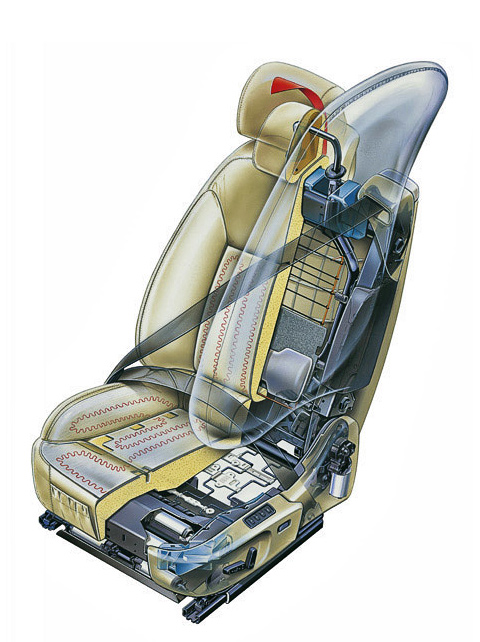
Переднее левое кресло Saab
9–3
с боковой подушкой безопасности и активным подголовником.
Системы «надувной» защиты уже давно не ограничиваются фронтальными подушками. Конструкторы разработали аналогичные системы для защиты человека при боковом ударе. В базовое оснащение многих современных авто уже входят боковые подушки, вмонтированные в спинки передних сидений, а также надувные «занавески», которые размещаются в рёбрах крыши. Первые защищают тело пассажира при боковом ударе, а вторые — голову. В отличие от фронтальных подушек, которые сдуваются практически сразу после срабатывания, занавески могут сохранять давление в течение нескольких секунд, то есть до тех пор, пока опасная ситуация не минует. А при опрокидывании автомобиля они не дадут непристёгнутым пассажирам вылететь из салона.
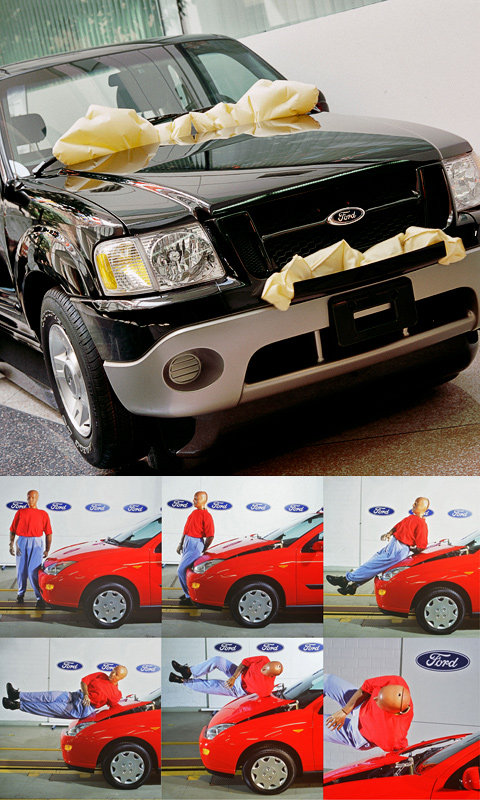
В борьбе за безопасность «надувные технологии» вышли за пределы автомобильного салона. В случае наезда внешние подушки раскрываются в местах наиболее вероятного контакта человека с автомобилем (перед бампером, у кромки капота). Кстати, капоты тоже проектируют специальным образом, снабжают их пиротехникой для того, чтобы они смогли максимально безвредно «принять» на себя пешехода.
Часто предлагается оснащать машину дополнительными подушками для защиты коленей и ступней. Многие производители оснащают свои автомобили подушками и для задних пассажиров. Но какой бы суперсовременной и умной ни была бы электроника на вашем автомобиле, не забывайте пристегиваться во время поездки. Ведь разрабатывая все эти сверхсовременные средства защиты, инженеры компаний исходят из одного постулата — водитель и пассажиры пристёгнуты ремнём безопасности. А если это не так, то толку от всех эти штук будет немного.
Под
пассивной
безопасностью подразумевают
комплекс эксплуатационных свойств
транспортного средства, обеспечивающих
снижение тяжести последствий ДТП.
Пассивная безопасность вступает в
действие, если водителю не удалось
избежать аварии, и обеспечивает
уменьшение инерционных нагрузок на
водителя и пассажиров, ограничение
перемещения их в кабине, защиту от травм,
увечий при ударе, устранение возможности
выбрасывания из кабины или салона
транспортного средства в момент
столкновения.
Различают
внутреннюю и внешнюю пассивную
безопасность. Под внутренней
пассивной безопасностью понимаются
свойства транспортного средства,
снижающие тяжесть последствий ДТП для
водителя и пассажиров, находящихся в
транспортном средстве.
Внешняя
пассивная безопасность —
свойства транспортного средства,
позволяющие снизить тяжесть последствий
для других участников ДТП (пешеходов,
водителей и пассажиров других транспортных
средств).
К комплексу пассивной
безопасности относятся: свойства:
демпфирующие свойства
передней и задней части автомобиля,
бамперов;
надежность закрывания
замков дверей; конструктивные особенности:
безосколочное
ветровое стекло;
энергопоглощающая
рулевая колонка;
системы ограничения
перемещения человека в салоне — ремни
безопасности, подголовники,
пневматические
подушки;
отсутствие острых
и жестких выступающих внутренних
панелей салона и ручек органов
управления;
средства защиты
пешеходов выступающими снаружи деталями
кузова автомобиля.
Эффективным
средством обеспечения безопасности
водителя и пассажиров автомобиля
являются ремни
безопасности. При
столкновении автомобиля на скорости
50 км/ч человек, не пристегнутый
ремнями, ударяется с силой, в 30 — 60 раз
превышающей его собственный вес.
По статистике, риск
серьезных ранений для пассажиров,
пристегнутых ремнями безопасности
на заднем сиденье, снижается в 2,86 раза.
Кроме того, непристегнутый пассажир,
находящийся на заднем сиденье, подвергает
риску не только себя, но и тех, кто сидит
спереди.
Внедрение современных
разработок значительно улучшает
эксплуатационные характеристики
ремней безопасности и повышает степень
защиты водителя и пассажиров. Последние
разработки включают в себя следующие
усовершенствования: регулировку
плечевого ремня безопасности; удлинитель
ремня безопасности; механизмы
предварительного и аварийного натяжения
ремня безопасности; систему управления
энергией (ограничители нагрузки,
пневматические ремни безопасности);
интегрированную систему сиденье —
ремень; ремни безопасности для центрального
заднего сиденья.
При
резких фронтальных ударах пассажиры
автомобиля получают ускорение до
(40 — 50)g.
Если
имеется надежное амортизирующее
средство, подобные ускорения могут быть
перенесены без значительных травм. Для
защиты водителя и пассажиров при
фронтальных ударах применяют системы
пневматических подушек, автоматически
срабатывающих за короткий промежуток
времени от момента удара автомобиля о
препятствие до момента удара тела
человека о рулевое колесо или элементы
интерьера (0,03…0,04 с). При срабатывании
пневматических подушек рассеивается
до 90 % кинетической энергии удара.
По результатам
исследований, проведенных в США,
пневматические подушки снижают риск
смертельного исхода для водителей:
на 31 % при прямом
лобовом столкновении;
19 % при
всех лобовых столкновениях;
11 % при
любом другом столкновении.
При испытаниях на
лобовое столкновение легковых
автомобилей, оборудованных
пневматическими подушками, принимая в
расчет их массу, были получены следующие
результаты снижения риска гибели
водителя:
• легкие автомобили
(вес до 1 260 кг) — на 31 %;
• средние автомобили
(вес 1 260… 1 420 кг) — на 25 %;
• тяжелые автомобили
(вес более 1 420 кг) — на 39%. Надежность
защиты водителя и пассажиров от получения
травм различной степени тяжести и гибели
увеличивается при комбинировании
разных систем ограничения перемещения
человека в салоне.
Так, в.случае
использования пневматических подушек
снижение риска получения травм,
угрожающих жизни человека, достигает
40%, травм средней тяжести — 10%, а при
совместном использовании пневматических
подушек и ремней безопасности
соответственно 64 и 66 %.
В случае бокового
столкновения водитель и пассажиры
получают серьезные ранения от удара
о дверь. Для того чтобы снизить тяжесть
таких ранений, для дверей используют
специальные заполнители и современные
композитные материалы, хорошо поглощающие
энергию удара. Некоторые производители
оборудуют свои автомобили системами
защиты от удара о боковые элементы
автомобиля, а именно боковые пневматические
подушки (от удара о двери) и пневматические
шторы (от удара о наддверную часть
потолка). Такие системы постепенно
становятся обязательным атрибутом
новых автомобилей, их задача — поглощение
энергии удара головы и грудной клетки
человека о потолок, дверь и внешние
объекты (например, дерево, столб или
другое транспортное средство). Боковые
пневматические подушки могут
устанавливаться в двери, сиденье или
балке автомобильной рамы.
Важный
элемент внутреннего обустройства
автомобиля — сиденья.
Использование
сидений специальной конструкции может
существенно повысить безопасность
водителя и пассажиров, что достигается
применением амортизаторов, усилением
креплений сидений, фиксацией спинок
передних сидений защелками, ограничением
перемещения головы в момент удара при
помощи подголовников. В последние
годы серьезное внимание стали уделять
надежному креплению подушки заднего
сиденья и его спинки. При фиксации спинок
сидений с помощью защелки пассажиры на
заднем сиденье не ударяются о детали
интерьера передней части салона.
Большое внимание
должно уделяться пассивной безопасности
детей. Детей массой до 9 кг обязательно
следует перевозить в детском кресле
с обратной посадкой, установленном на
заднем сиденье и пристегнутом ремнями
безопасности. Заднее сиденье всегда
безопаснее переднего, даже оборудованного
пневматической подушкой.
Детей массой более
9 кг следует перевозить в детском кресле
с посадкой лицом вперед, а затем в детском
удерживающем устройстве. В любом
случае дети в возрасте до 12 лет должны
находиться только на заднем сиденье
и быть пристегнутыми ремнями безопасности.
По результатам исследований, для ребенка,
сидящего на заднем сиденье, риск
гибели при лобовом столкновении на 36 %
ниже, чем для ребенка на переднем сиденье.
Последнее время
многие производители автомобилей начали
оборудовать свои модели сиденьями
нового стандарта, которые облегчают
установку детского кресла и повышают
безопасность ребенка.
Большое
внимание уделяется исследованию влияния
рулевой
колонки на
безопасность водителя при ДТП. При
хорошо сконструированной и правильно
расположенной рулевой колонке опасность
травмирования водителя уменьшается на
30…40 %. Имеются разные конструкции
безопасного рулевого колеса, например
снабженные предохранительной мягкой
накладкой, рулевое колесо с гибким
ободом.
Снижение тяжести
последствий ДТП для других участников
дорожного движения является неотъемлемой
характеристикой современного автомобиля.
Испытания автомобилей
показывают:
конструкция автомобиля
определяет тяжесть ранения пешехода
и степень повреждения другого автомобиля
в случае ДТП. Например, изменение
конструкции капота таким образом, чтобы
между крышкой капота и верхними элементами
двигателя находилось не менее 50…80
мм пустого пространства, уже позволяет
значительно снизить тяжесть травм
пешехода в случае ДТП;
алюминиевый капот
лучше поглощает энергию удара, поэтому
снижает тяжесть последствий ДТП для
пешехода;
при
наезде на пешеходов до 55 % всех травм
пешеходов вызвано ударом о бампер.
Тяжесть травм коленей пешеходов
возрастает, если бампер автомобиля
расположен на высоте 0,5…0,53 м от
поверхности
дороги. Если бампер расположен на уровне
половины тела человека, пешеход
получает еще более тяжелые травмы
тазовых костей. Таким образом, чем ниже
расположен бампер, тем меньше вероятность
травм коленей и тазовых костей, а чем
меньше жесткость бампера, тем меньше
тяжесть этих травм.
Соседние файлы в предмете [НЕСОРТИРОВАННОЕ]
- #
- #
- #
- #
- #
- #
- #
- #
- #
- #
- #
Automotive safety is the study and practice of automotive design, construction, equipment and regulation to minimize the occurrence and consequences of traffic collisions involving motor vehicles. Road traffic safety more broadly includes roadway design.
One of the first formal academic studies into improving motor vehicle safety was by Cornell Aeronautical Laboratory of Buffalo, New York. The main conclusion of their extensive report is the crucial importance of seat belts and padded dashboards.[1] However, the primary vector of traffic-related deaths and injuries is the disproportionate mass and velocity of an automobile compared to that of the predominant victim, the pedestrian.[citation needed]
According to the World Health Organization (WHO), 80% of cars sold in the world are not compliant with main safety standards. Only 40 countries have adopted the full set of the seven most important regulations for car safety.[2]
In the United States, a pedestrian is injured by a motor vehicle every 8 minutes, and are 1.5 times more likely than a vehicle’s occupants to be killed in a motor vehicle crash per outing.[3]
Improvements in roadway and motor vehicle designs have steadily reduced injury and death rates in all first world countries. Nevertheless, auto collisions are the leading cause of injury-related deaths, an estimated total of 1.2 million in 2004, or 25% of the total from all causes. Of those killed by autos, nearly two-thirds are pedestrians.[4] Risk compensation theory has been used in arguments against safety devices, regulations and modifications of vehicles despite the efficacy of saving lives.[5]
Coalitions to promote road and automotive safety, such as Together for Safer Roads (TSR), brings together global private sector companies, across industries, to collaborate on improving road safety. TSR brings together members’ knowledge, data, technology, and global networks to focus on five road safety areas that will make an impact globally and within local communities.[6]
The rising trend of autonomous things is largely driven by the move towards the autonomous car, that both addresses the main existing safety issues and creates new issues. The autonomous car is expected to be safer than existing vehicles, by eliminating the single most dangerous element — the driver. The Center for Internet and Society at Stanford Law School claims that «Some ninety percent of motor vehicle crashes are caused at least in part by human error».[7] But while safety standards like the ISO 26262 specify the required safety, it is still a burden on the industry to demonstrate acceptable safety.
Occupational driving[edit]
Work-related roadway crashes are the leading cause of death from traumatic injuries in the U.S. workplace. They accounted for nearly 12,000 deaths between 1992 and 2000. Deaths and injuries from these roadway crashes result in increased costs to employers and lost productivity in addition to their toll in human suffering.[8] Truck drivers tend to endure higher fatality rates than workers in other occupations, but concerns about motor vehicle safety in the workplace are not limited to those surrounding the operation of large trucks. Workers outside the motor carrier industry routinely operate company-owned vehicles for deliveries, sales and repair calls, client visits, etc. In these instances, the employer providing the vehicle generally plays a major role in setting safety, maintenance, and training policy.[8] As in non-occupational driving, young drivers are especially at risk. In the workplace, 45% of all fatal injuries to workers under age 18 between 1992 and 2000 in the United States resulted from transportation incidents.[9]
Active and passive safety[edit]
The terms «active» and «passive» are simple but important terms in the world of automotive safety. «Active safety» is used to refer to technology assisting in the prevention of a crash and «passive safety» to components of the vehicle (primarily airbags, seatbelts and the physical structure of the vehicle) that help to protect occupants during a crash.[10][11]
Crash avoidance[edit]
Crash avoidance systems and devices help the driver — and, increasingly, help the vehicle itself — to avoid a collision. This category includes:
- The vehicle’s headlamps, reflectors, and other lights and signals
- The vehicle’s mirrors
- The vehicle’s brakes, steering, and suspension systems
Driver assistance[edit]
A subset of crash avoidance is driver assistance systems, which help the driver to detect obstacles and to control the vehicle. Driver assistance systems include:
- Driver Alertness Detection System (DADS) to help prevent crashes caused by fatigue, lack of alertness, or distractions[12]
- Advanced emergency braking system systems to prevent or reduce the severity of collision.
- Infrared night vision systems to increase seeing distance beyond headlamp range
- Adaptive headlamps control the direction and range of the headlight beams to light the driver’s way through curves and maximize seeing distance without partially blinding other drivers
- Reverse backup sensors, which alert drivers to difficult-to-see objects in their path when reversing
- Backup camera
- Adaptive cruise control which maintains a safe distance from the vehicle in front
- Lane departure warning systems to alert the driver of an unintended departure from the intended lane of travel
- Tire pressure monitoring systems or Deflation Detection Systems
- Traction control systems which restore traction if driven wheels begin to spin
- Electronic Stability Control, which intervenes to avert an impending loss of control
- Anti-lock braking systems
- Electronic brakeforce distribution systems
- Emergency brake assist systems
- Cornering Brake Control systems
- Assured Clear Distance Ahead measurement and speed governance systems
- Precrash system
- Automated parking system
- Obstacle detection sensor systems notify a driver how close their vehicle is to an object — usually providing a distance measurement, to the inch, as to how close they are.
Crashworthiness[edit]
Crashworthy systems and devices prevent or reduce the severity of injuries when a crash is imminent or actually happening. Much research is carried out using anthropomorphic crash test dummies.
- Seatbelts limit the forward motion of an occupant, stretch to absorb energy, to lengthen the time of the occupant’s negative acceleration in a crash, reducing the loading on the occupants’ body. They prevent occupants being ejected from the vehicle and ensure that they are in the correct position for the operation of the airbags.
- Airbags inflate to cushion the impact of a vehicle occupant with various parts of the vehicle’s interior. The most important being the prevention of direct impact of the driver’s head with the steering wheel and door pillar.
- Laminated windshields remain in one piece when impacted, preventing penetration of unbelted occupants’ heads and maintaining a minimal but adequate transparency for control of the car immediately following a collision. It is also a bonded structural part of the safety cell. Tempered glass side and rear windows break into granules with minimally sharp edges, rather than splintering into jagged fragments as ordinary glass does.
- Crumple zones absorb and dissipate the force of a collision, displacing and diverting it away from the passenger compartment and reducing the negative acceleration impact force on the vehicle occupants. Vehicles will include a front, rear and maybe side crumple zones (like Volvo SIPS) too.
- Safety Cell—the passenger compartment is reinforced with high strength materials, at places subject to high loads in a crash, in order to maintain a survival space for the vehicle occupants. Footwell intrusion is one recognized failure mode of the safety cell, and anti-intrusion bars are one component addressing protection in side impacts.
- Collapsible universally jointed steering columns, along with steering wheel airbag. The steering system is mounted behind the front axle — behind and protected by, the front crumple zone. This reduces the risk and severity of driver impact or even impalement on the column in a frontal crash.
- Pedestrian protection systems.
- Padding of the instrument panel and other interior parts, on the vehicle in areas likely to be struck by the occupants during a crash, and the careful placement of mounting brackets away from those areas.
- Cargo barriers are sometimes fitted to provide a physical barrier between passenger and cargo compartments in vehicles such as SUVs, station wagons and vans. These help prevent injuries caused by occupants being struck by unsecured cargo. They can also help prevent collapse of the roof in the event of a vehicle rollover.
Post-crash survivability[edit]
Post-crash survivability is the chance that drivers and passengers survive a crash after it occurs. Technology such as Advanced Automatic Collision Notification can automatically place calls to emergency services and send information about a vehicle collision.
Pedestrian safety[edit]
Cars are much more dangerous to pedestrians than they are to drivers and passengers. Two-thirds of 1.3 million yearly auto related deaths are pedestrians.[13] Since at least the early 1970s, attention has also been given to vehicle design regarding the safety of pedestrians in car-pedestrian collisions. Proposals in Europe would require cars sold there to have a minimum/maximum hood (bonnet) height.[14] From 2006, the use of «bull bars», a fashion on 4x4s and SUVs, became illegal in the European Union, after having been banned on all new cars in 2002.[15]
Conspicuity[edit]
Lights and reflectors[edit]
Vehicles are equipped with a variety of lights and reflectors to mark their presence, position, width, length, and direction of travel as well as to convey the driver’s intent and actions to other drivers. These include the vehicle’s headlamps, front and rear position lamps, side marker lights and reflectors, turn signals, stop (brake) lamps, and reversing lamps. School buses and semi-trailer trucks in North America are required to bear retroreflective strips outlining their side and rear perimeters for greater conspicuity at night.[16]
Daytime running lamps have been required in the Nordic countries since the mid-1970s, in Canada since 1990, and throughout the European Union since 7 February 2011.[17][18]
Vehicle colour[edit]
A 2004 essay on the relation between car colour and safety stated that no previous studies had been scientifically conclusive.[19] Since then, a Swedish study found that pink cars are involved in the fewest and black cars are involved in the most crashes (Land transport NZ 2005). In Auckland New Zealand, a study found that there was a significantly lower rate of serious injury in silver cars, with higher rates in brown, black, and green cars. The Vehicle Colour Study, conducted by Monash University Accident Research Centre (MUARC) and published in 2007, analysed 855,258 crashes that occurring between 1987 and 2004 in the Australian states of Victoria and Western Australia that resulted in injury or in a vehicle being towed away.[20] The study analysed risk by light condition. It found that in daylight, black cars were 12% more likely than white to be involved in a collision, followed by grey cars at 11%, silver cars at 10%, and red and blue cars at 7%, with no other colours found to be significantly more or less risky than white. At dawn or dusk, the risk ratio for black cars jumped to 47% more likely than white, and that for silver cars to 15%. In the hours of darkness, only red and silver cars were found to be significantly more risky than white, by 10% and 8% respectively.[citation needed]
Unused safety features[edit]
Many different inventions and ideas which may or may not have been practical about auto safety have been put forward but never made it to a production car. Such items include the driver seat in the middle (to give the person a better view)[21] (the exception being the McLaren F1 super car) and control stick steering.[citation needed]
History[edit]
18th century–19th century[edit]
Automotive safety may have become an issue almost from the beginning of mechanised road vehicle development. The second steam-powered «Fardier» (artillery tractor), created by Nicolas-Joseph Cugnot in 1771, is reported by some to have crashed into a wall during its demonstration run. However, according to Georges Ageon,[22] the earliest mention of this occurrence dates from 1801 and it does not feature in contemporary accounts. One of the earliest recorded car-related fatalities was Mary Ward, on August 31, 1869, in Parsonstown, Ireland.[23]
1920s[edit]
In 1922, the Duesenburg Model A became the first car to have four-wheel hydraulic brakes.[24]
1930s[edit]
In 1930, safety glass became standard on all Ford cars.[25] In the 1930s, plastic surgeon Claire L. Straith and physician C. J. Strickland advocated the use of seat belts and padded dashboards. Strickland founded the Automobile Safety League of America.[26][27]
In 1934, GM performed the first barrier crash test.[28]
In 1936, the Hudson Terraplane came with the first back-up brake system. Should the hydraulic brakes fail, the brake pedal would activate a set of mechanical brakes for the back wheels.[29][30]
In 1937, Chrysler, Plymouth, DeSoto, and Dodge added such items as a flat, smooth dash with recessed controls, rounded door handles, a windshield wiper control made of rubber, and the back of the front
seat heavily padded to provide protection for rear passengers.[31][32][33][34][35][36]
1940s[edit]
In 1942, Hugh DeHaven published the classic Mechanical analysis of survival in falls from heights of fifty to one hundred and fifty feet.[37]
In 1947, the American Tucker was built with the world’s first padded dashboard. It also came with middle headlight that turned with the steering wheel, a front steel bulkhead, and a front safety chamber.[38]
In 1949, SAAB incorporated aircraft safety thinking into automobiles making the Saab 92 the first production SAAB car with a safety cage.[39]
Also in 1949, the Chrysler Imperial Crown was the first car to come with standard disc brakes.[40][41]
1950s[edit]
In 1955, a USAF surgeon who advised the US Surgeon General wrote an article on how to make cars safer for those riding in it. Aside from the usual safety features, such as seat belts and padded dashboards, bumper shocks were introduced.[42]
In 1956, Ford tried unsuccessfully to interest Americans in purchasing safer cars with their Lifeguard safety package. (Its attempt nevertheless earns Ford Motor Trend‘s «Car of the Year» award for 1956.)[43]
In 1958, the United Nations established the World Forum for Harmonization of Vehicle Regulations, an international standards body advancing auto safety. Many of the most life saving safety innovations, like seat belts and roll cage construction were brought to market under its auspices. That same year, Volvo engineer Nils Bohlin invented and patented the three-point lap and shoulder seat belt, which became standard equipment on all Volvo cars in 1959.[44] Over the next several decades, three-point safety belts were gradually mandated in all vehicles by regulators throughout the industrialised world.[citation needed]
In 1959, American Motors Corporation offered the first optional head rests for the front seat.[45] Also in 1959, the Cadillac Cyclone concept by Harley Earl had «a radar-based crash-avoidance system» located in the on the nose cones of the vehicle that would make audible and visual signals to the driver if there were obstacles in the vehicle’s path.[46]
1960s[edit]
Effective on new passenger cars sold in the United States after January 1, 1964. front outboard lap belts were required.[citation needed]
On September 9, 1966, the National Traffic and Motor Vehicle Safety Act became law in the U.S., the first mandatory federal safety standards for motor vehicles.[47]
Effective in 1966, US-market passenger cars were required to be equipped with padded instrument panels, front and rear outboard lap belts, and white reverse (backup) lamps.[citation needed]
In 1966, the U.S. established the United States Department of Transportation (DOT) with automobile safety as one of its purposes. The National Transportation Safety Board (NTSB) was created as an independent organization on April 1, 1967, but was reliant on the DOT for administration and funding. However, in 1975 the organization was made completely independent by the Independent Safety Board Act (in P.L. 93-633; 49 U.S.C. 1901).[citation needed]
In 1967, equipment specifications by such major fleet purchasers as the City and County of Los Angeles, California, encouraged the voluntary installation in most new cars sold in the US of safety devices, systems, and design features including:[48]
- Elimination of protruding knobs and controls in passenger compartment
- Additional padding on the instrument panel and other interior surfaces
- Mounting points for front outboard shoulder belts
- Four-way hazard flashers
- A uniform P-R-N-D-L gear sequence for automatic transmission gear selectors
- Dual-circuit brake hydraulic systems
In 1968, the precursor agency to the US National Highway Traffic Safety Administration’s first Federal Motor Vehicle Safety Standards took effect. These required shoulder belts for left and right front-seat vehicle occupants, side marker lights, collapsible steering columns, and other safety features. 1969 saw the addition of head restraints for front outboard passengers, addressing the problem of whiplash in rear-end collisions. These safety requirements did not apply to vehicles classified as «commercial,» such as light-duty pickup trucks. Thus, manufacturers did not always include such hardware in these vehicles, even though many did passenger-car duty.[citation needed]
Volvo developed the first rear-facing child seat in 1964 and introduced its own booster seat in 1978.[49]
1970s[edit]
In 1974, GM offered driver and passenger airbags as optional equipment on large Cadillacs, Buicks, and Oldsmobiles.[50]
In 1979, NHTSA began crash-testing popular cars and publishing the results, to inform consumers and encourage manufacturers to improve the safety of their vehicles. Initially, the US NCAP (New Car Assessment Program) crash tests examined compliance with the occupant-protection provisions of FMVSS 208. Over the subsequent years, this NHTSA program was gradually expanded in scope.
1980s[edit]
In 1984, New York State passed the first U.S. law requiring seat belt use in passenger cars. Seat belt laws have since been adopted by 49 states (New Hampshire has not).[51] NHTSA estimates the resulting increased seat belt use saves 10,000 per year in the United States.[52]
In 1986, the central 3rd brake light was mandated in North America with most of the world following with similar standards in automotive lighting.[53]
Airbags were first installed in production vehicles in the 1980s as standard equipment instead of an option as was done in the mid-1970s (such as the Oldsmobile Toronado in 1974[50][54][55]). In 1981, airbags were an available option on the Mercedes-Benz W126 (S-Class). In 1987, the Porsche 944 Turbo became the first car to have driver and passenger airbags as standard equipment, and airbags were offered as an available option on the 944 and 944S. The first airbag was also installed in a Japanese car, the Honda Legend, in 1987.[56] In 1988, Chrysler was the first United States company to install standard driver’s side air bags, in six of its passenger models.[57] In 1989, Chrysler became the first U.S. auto manufacturer to install driver-side air bags in all its domestic-built automobiles.[58]
1990s[edit]
In 1995, the Insurance Institute for Highway Safety (IIHS) began frontal offset crash tests.[citation needed]
Also in the same year, Volvo introduced the world’s first car with side airbags: the 850.
In 1996, the European New Car Assessment Programme (Euro NCAP) was established to test new vehicles’ safety performance and publish the results for vehicle shoppers’ information.[59] The NHTSA crash tests are presently operated and published as the U.S. branch of the international NCAP programme.[60]
2000s[edit]
In 2000, the NHTSA released a regulation making trunk releases mandatory for new cars by September of the following year due, in part, to the lobbying efforts of Janette Fennell.[61]
In 2003, the IIHS began conducting side impact crash tests. In 2004, NHTSA released new tests designed to test the rollover risk of new cars and SUVs. Only the Mazda RX-8 got a 5-star rating.[citation needed]
In 2009, Citroën became the first manufacturer to feature «Snowmotion», an Intelligent Anti Skid system developed in conjunction with Bosch, which gives drivers a level of control in extreme ice or snow conditions similar to a 4×4.[62]
In 2009, NHTSA upgraded its roof-crush standard for vehicles weighing 6000 pounds or less. The new standard increased the crush load requirement from 1.5 to 3 times the vehicle’s curb weight.[63][64]
2010s[edit]
From 2011, new cars should have brake assist system in the EU, according to The Pedestrian Protection Regulation (EC) 78/2009.[65]
Starting in 2012, all cars under 10,000 lbs. sold in the US are required to have Electronic Stability Control.[66]
In 2014, ESP (Electronic Stability Program) and TPMS became mandatory in the European Union, with also the driver seat belt reminder and the ISOFIX system, under General Safety Regulation (EC) No 661/2009.[67]
In 2015, recognizing that safer roads are a shared responsibility, Together for Safer Roads (TSR) was formally launched to align the private sector’s road safety efforts with the United Nations Decade of Action for Road Safety.[6]
In 2016 and 2017, ABS became mandatory on motorcycles in the EU.[68]
In 2018, eCall became mandatory in the EU, and reverse camera in the US.[69]
In 2019, the EU legislated to revise the General Safety Regulation (GSR), the revision includes the following automotive safety features:[70]
- Intelligent Speed Assistance (ISA)
- Drowsiness Alerts (DDR-AW)
- Distraction Alerts
- Event Data Recorders (EDR)
- Advanced Emergency Braking
- Alcohol Interlock Installation Facilitation (ALC)
- Tire-pressure monitoring system (TPMS)
- Emergency Stop Signals (ESS)
- Lane Departure Warning Systems
- Reversing Detection (REV)
- Safety-belt Warning Systems covering all the seats in a vehicle
- Vehicle Master Control Switches
- Driver Availability Monitoring Systems
In addition, a number of regulatory changes have been made in the update to the GSR in relation to vehicle design, in which the following have been mandated:[70]
- Enlargement of Head Impact Zones.
- Reduction of blind spots for buses, vans and HGVs.
- Improved easy access, for people with low levels of mobility, on buses which have a capacity over 22 persons, and which allow standing.
- Regulation in relation to frontal protection systems.
- Previously vans, SUVs and MPVs were exempted from regulations pertaining to height and vehicle characteristics, these exemptions have been revised.
Safety trends[edit]
In the US, about 34,000 people were killed by traffic crashes every year from 2015 to 2020.[71] Sharp rises in the price of fuel and related driver behavioural changes reduced 2007-8 highway fatalities in the US to below the 1961 fatality count.[72] Litigation played a large part in mandating safer cars.[73]
Safety is a significant concern in the European Union (EU 28) with 25,249[74] fatalities and around 130,000[75] serious injuries in 2018 and 2017 respectively. Overall, between 2001 and 2018 there was an almost 50% reduction in road deaths in the EU from 55,092 in 2001 to the 2018 figure of 25,249.[74] In 2018 the EU average road death rate was 49 people per million inhabitants.[74] Also in 2018 Romania had the worst figures in this regard with 96 people out of a million inhabitants dying on the roads, Belgium had the median score standing at 52 deaths per million, and the UK scored the best with 28 people out of every million dying on its roads.[74]
International comparison[edit]
In 1996, the US had about 2 deaths per 10,000 motor vehicles, compared to 1.9 in Germany, 2.6 in France, and 1.5 in the UK.[76] In 1998, there were 3,421 fatal crashes in the UK, the fewest since 1926;[77] in 2010 this number was further reduced to 1,857 and was attributed to the 2009–2010 scrappage scheme.[78]
The sizable traffic safety lead enjoyed by the US since the 1960s had narrowed significantly by 2002, with the US improvement percentages lagging in 16th place behind those of Australia, Austria, Canada, Denmark, Finland, Germany, United Kingdom, Iceland, Japan, Luxembourg, the Netherlands, New Zealand, Norway, Sweden, and Switzerland in terms of deaths per thousand vehicles, while in terms of deaths per 100 million vehicle miles travelled, the US had dropped from first place to tenth place.[79]
US specificities[edit]
Transportation safety in the United States is monitored by various agencies.
Research on the trends in use of heavy vehicles indicate that a significant difference between the US and other countries is the relatively high prevalence of pickup trucks and SUVs in the US. A 2003 study by the US Transportation Research Board found that SUVs and pickup trucks are significantly less safe than passenger cars, that non-US branded vehicles tend to be safer than US branded vehicles, and that the size and weight of a vehicle has a significantly smaller effect on safety than the quality of the vehicle’s engineering.[82] In the US, the level of large commercial truck traffic has substantially increased since the 1960s, while highway capacity has not kept pace with the increase in large commercial truck traffic on US highways.[83] However, other factors exert significant influence; Canada has lower roadway death and injury rates despite a vehicle mix comparable to that of the US.[79] Nevertheless, the widespread use of truck-based vehicles as passenger carriers is correlated with roadway deaths and injuries not only directly by dint of vehicular safety performance per se, but also indirectly through the relatively low fuel costs that facilitate the use of such vehicles in North America; motor vehicle fatalities decline as fuel prices increase.[72][84]
The US NHTSA has issued relatively few regulations since the mid-1980s; most of the vehicle-based reduction in vehicle fatality rates in the US during the last third of the 20th Century were gained by the initial NHTSA safety standards issued from 1968 to 1984 and subsequent voluntary changes in vehicle design and construction by vehicle manufacturers.[85]
Issues for particular demographic groups[edit]
Pregnant women[edit]
When pregnant, women should continue to use seatbelts and airbags properly. A University of Michigan study found that «unrestrained or improperly restrained pregnant women are 5.7 times more likely to have an adverse fetal outcome than properly restrained pregnant women».[86] If seatbelts are not long enough, extensions are available from the car manufacturer or an aftermarket supplier.[citation needed]
Infants and children[edit]
Children present significant challenges in engineering and producing safe vehicles, because most children are significantly smaller and lighter than most adults. Additionally, children far from being just scaled down adults, still have an undeveloped skeletal system. This means that vehicle restraint systems such as airbags and seat belts, far from being effective, are hazardous if used to restrain young children. In recognition of this, many medical professionals and jurisdictions recommend or require that children under a particular age, height, and/or weight ride in a child seat and/or in the back seat, as applicable.[citation needed]
Within Europe ECE Regulation R44 dictates that children below 150 cm must travel in a child restraint that is appropriate for their weight. Each country have their own adaptions of this Regulation. For instance, in the United Kingdom, children must travel in a child restraint until they are 135 cm tall or reach 12 years of age, which ever comes soonest. As another example, in Austria, the driver of passenger vehicles is responsible for people shorter than 150 cm and below 14 years to be seated in an adequate child safety seat. Moreover, it is not allowed for children below the age of 3 to ride in a passenger vehicle without «security system» (which in practice means the vehicle is not equipped with any seat belts or technical systems like Isofix), whereas children between 3 and 14 years have to ride in the back seat.[87]
Sweden specify that a child or an adult shorter than 140 cm is legally forbidden to ride in a place with an active airbag in front of it.[citation needed]
The majority of medical professionals and biomechanical engineers agree that children below the age of two years old are much safer if they travel in a rearward facing child restraint.[88]
Child safety locks and driver-controlled power window lockout controls prevent children from opening doors and windows from inside the vehicle.[citation needed]
- Infants left in cars
Very young children can perish from heat or cold if left unattended in a parked car, whether deliberately or through absent-mindedness.[89] In 2004, the U.S. NHTSA estimated 25 fatalities per year among children left in hot cars.[90]
Teenage drivers[edit]
In the UK, a full driving licence can be had at age 17, and most areas in the United States will issue a full driver’s license at the age of 16, and all within a range between 14 and 18.[91] In addition to being relatively inexperienced, teen drivers are also cognitively immature, compared to adult drivers.[92] This combination leads to a relatively high crash rate among this demographic.[92]
In some areas, new drivers’ vehicles must bear a warning sign to alert other drivers that the vehicle is being driven by an inexperienced and learning driver, giving them opportunity to be more cautious and to encourage other drivers to give novices more leeway.[93] In the U.S. New Jersey has Kyleigh’s Law citing that teen drivers must have a decal on their vehicle.[94]
Some countries, such as Australia, the United States, Canada and New Zealand, have graduated levels of driver’s licence, with special rules.[95] By 2010, all US states required a graduated driver’s licence for drivers under age 18. In Italy, the maximum speed and power of vehicles driven by new drivers is restricted. In Romania, the maximum speed of vehicles driven by new drivers (less than one year in experience) is 20 km/h lower than the national standard (except villages, towns and cities). Many U.S. states allow 18-year-olds to skip some requirements that younger drivers would face, which statistics show may be causing higher crash rates among new drivers. New Jersey has the same requirements for new drivers up to the age of 21, which may obviate this problem.[96]
Medical conditions[edit]
According to a study[97] published in 2017 in the Mayo Clinic Proceedings, although most drivers with medical conditions were safe drivers, drivers with psychiatric conditions or substance abuse were particularly at higher risks of unsafe driving. The study also reported that drivers with neurological conditions were the majority of the entire study population (Belgium) who were referred for a driving evaluation, but they were not the most unsafe drivers.
Elderly[edit]
Insurance statistics in the United States indicate a 30% increase in the number of elderly killed, comparing 1975 to 2000.[98]
Several states require additional testing for elderly drivers. On a per-driver basis, the number of fatal and overall crashes decreases with age, with some exceptions for drivers over 75.[99] The overall trend may be due to greater experience and avoiding driving in adverse conditions.[98] However, on a per-miles-travelled basis,[100] drivers younger than 25-30 and older than 65-70 have significantly higher crash rates. Survivability of crashes decreases monotonically with the age of the victim.[100]
A common problem for the elderly is the question of when a medical condition or biological aging presents a serious enough problem that one should stop driving. In some cases, this means giving up some personal independence, but in urban areas often means relying more on public transportation. Many transit systems offer discounted fares to seniors,[101] and some local governments run «senior shuttles» specifically targeted at this demographic.[102]
Vehicle programs[edit]
While it is usually considered that the driver has the responsibility when collisions occur, vehicle can also contribute to collisions, up to 3% to 5% of crashes.[103]
Two kinds of programs exist: new car assessment program for new cars, and vehicle inspections for other ones.
NCAP[edit]
A New Car Assessment Program is a government or institutional car safety program tasked with evaluating new car designs for performance against various safety threats.
Two well known NCAP are United States New Car Assessment Program since 1978 and European New Car Assessment Programme since 1997.
Legal vehicle inspections[edit]
Vehicle inspection is a procedure mandated by national or subnational governments in many countries, in which a vehicle is inspected to ensure that it conforms to regulations governing safety, emissions, or both. Inspection can be required at various times, e.g., periodically or on the transfer of title to a vehicle.
If required periodically, it might be termed periodic motor vehicle inspection, or MOT test in the UK, or roadworthiness test in EU directives. Typical intervals are every two years (in EU) and every year (in UK). When a vehicle passes inspection, often a sticker is placed on the vehicle’s windshield or registration plate to simplify later controls, but in some countries (such as Netherlands since 1994) this is no longer necessary.
Vehicles are tested at inspection stations when due for inspection. Most US inspection decals/stickers display the month’s number and the year. They are called testing centre in EU directives.
Vehicle inspection exists in the United States.
In Victoria, Australia, safety features checked include the structure of the vehicle, the tires (depth of tread), the wheels, the engine, steering, suspension, brakes, and lights and seatbelts.[103]
Other safety measures[edit]
Tires should be checked regularly.[104]
Tire checking is important, because proper contact between tire and road is required for adequate vehicle control.[105]
See also[edit]
- Automotive industry
- Assured Clear Distance Ahead
- Artificial Passenger
- Aurora safety car (1957)
- Automated highway system
- Automobile design
- Automobile safety rating
- Blind spot (vehicle)
- Car handling
- Crash test dummy
- Crashworthiness
- Criticism of sport utility vehicles
- Crumple zone
- Frontal Protection System
- Defensive driving
- Dooring
- Driverless car
- Emergency road service
- Euro NCAP
- Experimental Safety Vehicle
- Federal Motor Carrier Safety Administration (FMCSA)
- Global road safety for workers
- Hazard symbol
- Insurance Institute for Highway Safety
- Intelligent car
- Lateral Support
- Life Critical System
- Management systems for road safety
- Mobile phones and driving safety
- Motorcycle Safety
- National Highway Traffic Safety Administration
- National Transportation Safety Board
- Omniview technology
- Pedestrian Safety Through Vehicle Design
- Risk compensation
- Safe Driving Day
- Safety car
- Safety Engineer
- Safety Engineering
- Smart car
- Traffic psychology
- Traffic safety
- Travel safety
- Unsafe at Any Speed
- Vehicle inspection
- Vehicle inspection in the United States
- Vehicle recovery
- Vehicle safety technology
- Work-related road safety in the United States
- Road safety in Europe
References[edit]
- ^ Making the Death Seat Safer Popular Science July 1950
- ^ «OMS | 10 faits sur la sécurité routière dans le monde». WHO. Archived from the original on August 10, 2009.
- ^ «Injury Prevention and Control: Motor Vehicle Safety». Center for Disease Control and Prevention. Retrieved 2012-03-20.
- ^ «World Health Organization: World report on road traffic injury prevention (2004)». Who.int. 2010-12-12. Retrieved 2011-09-20.
- ^ MacKay, M (1985). «Seat belts and risk compensation». BMJ. 291 (6498): 757–758. doi:10.1136/bmj.291.6498.757. PMC 1419041. PMID 3929928.
- ^ a b «About Us – TogetherForSaferRoads». togetherforsaferroads.org. Archived from the original on 2019-11-05. Retrieved 2016-11-07.
- ^ «Human error as a cause of vehicle crashes». cyberlaw.stanford.edu. Retrieved April 18, 2017.
- ^ a b Pratt, Stephanie G.; et al. (September 2003). «Work-Related Roadway Crashes — Challenges and Opportunities for Prevention». NIOSH Hazard Review. The National Institute for Occupational Safety and Health. doi:10.26616/NIOSHPUB2003119. Archived from the original on 23 December 2008. Retrieved 2008-11-10.
- ^ Mardis, Anne L.; Stephanie G. Pratt (July 2003). «Preventing Deaths, Injuries and Illnesses of Young Workers». NIOSH Alert. The National Institute for Occupational Safety and Health. Archived from the original on 2 December 2008. Retrieved 10 November 2008.
- ^ «American Honda safety page». Corporate.honda.com. 2006-03-02. Retrieved 2011-09-20.
- ^ Gladwell, Malcolm (2004-01-12). «BIG AND BAD: How the S.U.V. ran over automotive safety» (PDF). The New Yorker. Archived from the original (PDF) on 2009-07-06. Retrieved 2009-07-24.
- ^ Roy, Sree (17 December 2014). «InterCore’s Driver Alertness Detection System (DADS)». Sleep Review. Retrieved 6 March 2021.
- ^ Road Safety, World Bank
- ^ «Pedestrian Safety». Car Design Online. Archived from the original on 2012-03-08. Retrieved 2012-03-20.
- ^ «EUROPE | Bull bars banned from next year». BBC News. 2001-11-27. Retrieved 2011-09-20.
- ^ «The Effectiveness of Retroreflective Tape on Heavy Trailers». Nhtsa.gov. Archived from the original on 2016-11-24. Retrieved 2011-09-20.
- ^ «Press Release «New cars equipped with daytime running lights as of today»«. Europa.eu. 2011-02-07. Retrieved 2011-09-20.
- ^ «DRL Mandate Takes Effect in Europe, R48 Countries». Drivingvisionnews.com. Retrieved 2011-09-20.
- ^ «Car Color and Safety» (PDF). AAA Foundation. Archived from the original (PDF) on 2012-05-04. Retrieved 2012-03-20.
- ^ «An Investigation into the Relationship between Vehicle Colour and Crash Risk» (PDF). Archived from the original (PDF) on 2011-06-07. Retrieved 2011-09-20.
- ^ «Popular Science». The Popular Science Monthly. Bonnier Corporation: 94. December 1956. ISSN 0161-7370. Retrieved 2014-12-12.
- ^ «Le fardier de Cugnot». Archived from the original on 2008-04-16.
- ^ «Mary Ward 1827–1869». Archived from the original on 2008-03-11.
- ^ «Directory Index: Duesenberg/1922 Duesenberg Model A Catalogue». oldcarbrochures.com. Retrieved 2014-12-12.
- ^ «Directory Index: Ford/1930 Ford/1930 Ford Brochure 02». oldcarbrochures.com. Retrieved 2014-12-12.
- ^ «History of Straith Clinic in Birmingham, Dearborn, and West Bloomfield MI». straithclinic.com.
- ^ The Seat Belt, Swedish Research and Development for Global Automotive Safety, ISBN 978-91-630-9389-0, page 13
- ^ «VEHICLE SAFETY PAST, PRESENT AND FUTURE» (PDF). aesvn.org. p. 3. Archived from the original (PDF) on October 8, 2007. Retrieved 2011-09-20.
- ^ «Directory Index: Hudson/1936 Hudson/1936 Hudson — How What Why». oldcarbrochures.com. p. 87. Retrieved 2014-12-12.
- ^ «Directory Index: Hudson/1936 Hudson/1936 Hudson — How What Why». oldcarbrochures.com. p. 89. Retrieved 2014-12-12.
- ^ «Directory Index: Chrysler and Imperial/1937 Chrysler/1937 Chrysler Brochure». oldcarbrochures.com. Retrieved 2012-01-08.
- ^ «Directory Index: Plymouth/1937 Plymouth/1937_Plymouth Biggest Value Brochure». Oldcarbrochures.com. Retrieved 2012-01-08.
- ^ «Directory Index: Dodge/1940 Dodge/1940 Dodge Brochure». oldcarbrochures.com. Retrieved 2012-01-08.
- ^ Kimes, Beverly (1996). standard catalog of American Cars 1805-1942. Krause publications. ISBN 978-0-87341-428-9.
- ^ «America on the Move; Publicizing Interior Hazards». amhistory.si.edu. 16 March 2012. Retrieved 2014-12-12.
- ^ «Popular Mechanics». google.com. Hearst Magazines. April 1937.
- ^ De Haven, H (2000). «Mechanical analysis of survival in falls from heights of fifty to one hundred and fifty feet». Injury Prevention. 6 (1): 62–b–68. doi:10.1136/ip.6.1.62-b. PMC 1730592. PMID 10728546.
- ^ «Directory Index: Tucker/album/album». Archived from the original on 2010-12-04. Retrieved 2014-12-12.
- ^ «Saab shows its first concept car». 2008-05-19. Archived from the original on 2008-05-19. Retrieved 2012-01-08.
- ^ Flory, Jr., J. «Kelly» (2008). American Cars, 1946-1959 Every Model Every Year. McFarland & Company, Inc., Publishers. ISBN 978-0-7864-3229-5.
- ^ «Directory Index: Chrysler and Imperial/1951 Chrysler/1951 Chrysler Imperial_Brochure». oldcarbrochures.com. Retrieved 2014-12-12.
- ^ «Safer Cars.» Popular Science, June 1955, pp. 27-30/252
- ^ Flory, J. «Kelly», Jr. American Cars 1946–1959 (Jefferson, NC: McFarland & Coy, 2008), p.701.
- ^ «Safety Innovation in Cars». volvocars.com. Archived from the original on 2016-11-13. Retrieved 2016-11-12.
- ^ «Directory Index: AMC/1959 AMC/1959 Rambler Wagons». oldcarbrochures.com. Retrieved 2014-12-12.
- ^ Del-Colle, Andrew (23 October 2015). «This Cadillac Concept Had Radar Crash-Avoidance in 1959». Road & Track. Retrieved 25 October 2015.
- ^ Hendrickson, Kimberly A. (2003). «National Traffic and Motor Vehicle Safety Act». In Kutler, Stanley I. (ed.). Dictionary of American History. Vol. 5 (3rd ed.). Charles Scribner’s Sons. pp. 561–562.
Signed into law by President Lyndon Johnson on 9 September 1966, this act created the first mandatory federal safety standards for motor vehicles.
- ^ Dharam Pal, Kashyap. «Safety and Security in Automobile and Its History» (PDF). 2017 International Journal of Creative Research Thoughts, Volume 5, Issue 1.
- ^ «A Case Study of the Acquisition of Swedish Volvo by Chinese Geely» (PDF). Blekinge Tekniska Högskola. 2011-02-01. Archived from the original (PDF) on 2011-08-12. Retrieved 2012-03-20.
- ^ a b «Directory Index: Oldsmobile/1974 Oldsmobile/1974 Oldsmobile Air Cushion Folder». oldcarbrochures.com. Archived from the original on 2014-12-13. Retrieved 2014-12-12.
- ^ «Safety belt and child restraint laws». Insurance Institute for Highway Safety. March 2018.
- ^ «Trends in Occupant Restraint Use and Fatalities». NHTSA. US Department of Transportation.
- ^ Bruce, Schlink (2012). Americans Held Hostage by the Environmentalist Movement. Dorrance Publishing. ISBN 9781434975362.
- ^ Bellis, Mary (22 January 2018). «The History of Airbags». ThoughtCo.
- ^ Lisa Wade McCormick (25 September 2006). «A Short History of the Airbag». Consumer Affairs.
- ^ «240 Landmarks of Japanese Automotive Technology — Subaru Legend airbag system». Society of Automotive Engineers of Japan. Archived from the original on 2014-11-23. Retrieved 16 March 2014.
- ^ Godshall, Jeffery. Form, Function, and Fantasy — seventy years of Chrysler design. Vol. 32. p. 71. ISBN 9781596139275. Retrieved 16 March 2014.
- ^ Shaw, William H. (2011). Business ethics. Wadsworth/Cengage. p. 220. ISBN 9780495808763. Retrieved 16 March 2014.
- ^ «Euro NCAP Timeline». Euroncap.com. Archived from the original on 1 June 2020. Retrieved 25 March 2018.
- ^ «US NCAP overview». Safecarguide.com. Archived from the original on 2012-09-12. Retrieved 2011-09-20.
- ^ O’Donnell, Jane (2003). «Driven to make cars safe for kids». USA Today: 6B.
- ^ «Citroen C5 with Snow Motion Intelligent Anti-Skid System». Autoevolution.com. 2010-12-18. Retrieved 2011-09-20.
- ^ Jensen, Christopher (5 May 2009). «Government Improves Roof-Crush Standards». New York Times.
- ^ NHTSA declines to revisit roof-crush standard- Consumer Reports Archived 2018-09-18 at the Wayback Machine
- ^ «BELGIUM: EU makes brake assist mandatory». just-auto.com. December 10, 2009.
- ^ «Vehicles with ESC». SaferCar.gov. NHTSA.
- ^ http://etsc.eu/wp-content/uploads/PIN-Flash-30-Final.pdf[bare URL PDF]
- ^ «Traffic Technology News | Tolling | Mapping». 4 May 2023.
- ^ Cosgrove, Jaclyn (14 May 2018). «Backup camera in every new car puts safety at forefront». chicagotribune.com.
- ^ a b «Search in the register». consilium.europa.eu. Retrieved 2019-07-04.
- ^ «FATALITY ANALYSIS REPORTING SYSTEM (FARS) ENCYCLOPEDIA». National Highway Traffic Safety Administration. 2016-01-29. Retrieved 2022-09-29.
- ^ a b Sivak, Michael (July 2008). «Is the U.S. on the Path to the Lowest Motor Vehicle Fatalities in Decades?». Umtri-2008-39. hdl:2027.42/60424.
- ^ Jain, Sarah S. Lochlann (2004). ««Dangerous Instrumentality»: The Bystander as Subject in Automobility». Cultural Anthropology. 19: 61–94. doi:10.1525/can.2004.19.1.61. S2CID 17924196.
- ^ a b c d «13th Annual Road Safety Performance Index (PIN) Report | ETSC». etsc.eu. Retrieved 2019-07-04.
- ^ «European Commission — PRESS RELEASES — Press release — Road safety: Data show improvements in 2018 but further concrete and swift actions are needed». europa.eu. Retrieved 2019-07-04.
- ^ «Estimating global road fatalities — Regional Analyses — Highly Motorised Countries». Archived from the original on July 4, 2010. Retrieved 2014-12-12.
- ^ «UK Road deaths fall to record low», BBC News, September 9, 1999.
- ^ «Scrappage cuts road death rate | News». Auto Express. Archived from the original on 2011-07-18. Retrieved 2011-09-20.
- ^ a b Evans, Leonard (2004). Traffic Safety. Science Serving Society. ISBN 978-0-9754871-0-5.
- ^ «OECD Data / Road Accidents». data.OECD.org. Organisation for Economic Co-operation and Development (OECD). 15 December 2023. Archived from the original on 6 July 2023.
- ^ Leonhardt, David (11 December 2023). «The Rise in U.S. Traffic Deaths / What’s behind America’s unique problem with vehicle crashes?». The New York Times. Archived from the original on 14 December 2023.
- ^ Wenzel, T.; Ross, M. (2003). «Are SUVs Safer than Cars? An Analysis of Risk by Vehicle Type and Model» (PDF). Transportation Research Board. Archived from the original (PDF) on 9 March 2008. Retrieved 2008-03-09.
- ^ Robertson, Leon S (2006). «Motor Vehicle Deaths: Failed Policy Analysis and Neglected Policy». Journal of Public Health Policy. 27 (2): 182–189. doi:10.1057/palgrave.jphp.3200074. PMID 16961196. S2CID 19954345.
- ^ Grabowski, David C; Morrisey, Michael A (2004). «Gasoline prices and motor vehicle fatalities». Journal of Policy Analysis and Management. 23 (3): 575–593. doi:10.1002/pam.20028.
- ^ L.S. Robertson (2007). Injury Epidemiology (book) (Third edition, pp. 186-194 ed.). Oxford University Press. ISBN 978-0-19-506956-3.
- ^ «Wearing a seat belt during pregnancy — Minnesota Department of Public Safety». Archived from the original on June 23, 2004. Retrieved 2014-12-12.
- ^
«Austrian «Kraftfahrgesetz» § 106 Abs. 5 (Motor Vehicles Act)». Federal Chancellery of Austria. Retrieved 2013-09-28. - ^ «Why going forward facing too soon could kill your child». Archived from the original on 2016-08-28. Retrieved 2016-04-29.
- ^ Courteney Stuart (2008-01-31). «The perfect storm: Family tragedy plays out in court». The Hook. Charlottesville. Archived from the original on 2 February 2008. Retrieved 2008-02-23.
- ^ «Unattended Children and Cars, retrieved 2011-08-15″. Nhtsa.gov. Archived from the original on 2011-10-24. Retrieved 2011-09-20.
- ^ «Driving in other states». golocalnet.com. Archived from the original on 2021-11-04. Retrieved 2006-08-31.
- ^ a b Williamson, Elizabeth (1 February 2005). «Brain Immaturity Could Explain Teen Crash Rate». Washington Post.
- ^ «Service NL». servicenl.gov.nl.ca. Archived from the original on April 17, 2007.
- ^ «Kyleigh’s Law, GDL, Driver Education, Crash Maps, Videos, Safety Tips & more… | New Jersey Teen Driving». Njteendriving.com. Retrieved 2011-09-20.
- ^ «Licence». Roads and Maritime Services. Archived from the original on 2008-03-02. Retrieved 2008-03-05.
- ^ Aubrey, Allison (September 14, 2011). «Fatal Car Crashes Drop For 16-Year-Olds, Rise For Older Teens». Shots — NPR’s Health Blog. Washington, DC: NPR. Archived from the original on 2011-11-07. Retrieved 2011-11-07.
{{cite web}}: CS1 maint: bot: original URL status unknown (link) - ^ Devos, Hannes; Akinwuntan, Abiodun E.; Tant, Mark; Ranchet, Maud; Moon, Sanghee (September 1, 2017). «Comparison of Unsafe Driving Across Medical Conditions». Mayo Clinic Proceedings. 92 (9): 1341–1350. doi:10.1016/j.mayocp.2017.06.003. PMID 28870353 – via mayoclinicproceedings.org.
- ^ a b «Online NewsHour: Elderly Drivers — August 14, 2001». Pbs.org. 2001-08-14. Archived from the original on 2013-04-02. Retrieved 2011-09-20.
- ^ «Age of Driver and Number in Accidents statistics — USA Census numbers». Allcountries.org. Retrieved 2011-09-20.
- ^ a b «Elderly Driving Statistics and Motor Vehicle Operation Laws» (PDF). 19 August 2009. Archived from the original (PDF) on 29 December 2009. Retrieved 2014-12-12.
- ^ «Reduced Fare Program». My Way There. Retrieved 20 June 2020.
- ^ «Service». Senior Shuttle Plus. Retrieved 20 June 2020.
- ^ a b «Research in developed countries suggests that vehicle defects cause about 3% to 5% of crashes». IRAP Road Safety Toolkit. Archived from the original on May 7, 2010.
- ^ «How to Check if Your Tires Are Safe for Driving this Winter Season». preferredmutual.com.
- ^ «Tyre tread depth and tyre safety checks | RAC Drive». rac.co.uk.
Further reading[edit]
- Furness, S; Connor, J; Robinson, E; Norton, R; Ameratunga, S; Jackson, R (2003). «Car colour and risk of car crash injury: Population based case control study». BMJ. 327 (7429): 1455–1456. doi:10.1136/bmj.327.7429.1455. PMC 300804. PMID 14684646.
- Wai Chen; Shengwei Cai (2005). «Ad hoc peer-to-peer network architecture for vehicle safety communications». IEEE Communications Magazine. 43 (4): 100–107. doi:10.1109/MCOM.2005.1421912. S2CID 10423453.
- Reumerman, H.-J; Roggero, M; Ruffini, M (2005). «The application-based clustering concept and requirements for intervehicle networks». IEEE Communications Magazine. 43 (4): 108–113. doi:10.1109/MCOM.2005.1421913. S2CID 11548000.
- «Safe vehicle colours». Land transport NZ. 2005. Archived from the original on 2 February 2006. Retrieved 2006-01-01.
- Peden M, McGee K, Sharma G (2002). «The injury chart book: a graphical overview of the global burden of injuries» (PDF). Geneva, World Health Organization. Archived (PDF) from the original on 24 November 2005. Retrieved 2006-01-01. ISBN 978-92-4-156220-1
- Physics Today, January 2006, «Vehicle Design and the Physics of Traffic Safety»
- Evans, Leonard (2004). Traffic Safety. Science Serving Society. ISBN 978-0-9754871-0-5.
External links[edit]
- European safety ratings
- Automotive Safety
- National Transportation Safety Board. (US)
- National agency for Automotive Safety & Victim’s Aid (NASVA) Archived 2007-03-22 at the Wayback Machine, Japan
- No More Flying Glass When Vehicles Collide Popular Science monthly, February 1919, bottom page 27, Scanned by Google Books
Что такое пассивные и активные системы безопасности автомобиля?
Современное авто — это всегда сочетание пассивных систем безопасности с активными системами.
Под пассивными системами безопасности в авто понимаются такие системы, которые включаются в работу, когда транспортное средство уже попало в ДТП. Либо предполагается, что они отработают при столкновении. К пассивным системам безопасности автомобиля принято относить следующие:
Кузов. Сам кузов должен выполняться прочным, чтобы выстоять при столкновении. При этом речь идет не только о качестве материалов, но и о качестве проектирования кузова. Даже в самых тяжелых ДТП он должен “складываться” таким образом, чтобы не навредить находящимся внутри кузова людям.
Двери автомобиля. Даже двери автомобиля принято относить к пассивным системам безопасности. Они должны быть сконструированы таким образом, чтобы была возможность покинуть салон при столкновении.
Ремни безопасности. Их принято относить к пассивными системам безопасности, поскольку они предотвращают нанесение травм водителю при столкновении. Обратите внимание: Не все пассивные системы безопасности в авто работают без участия водителя или пассажиров. Яркий тому пример — ремни безопасности. Люди в салоне автомобиля должны сами себя пристегнуть ремнями до начала поездки, чтобы они сработали при ДТП, если оно произойдет.
Подголовники. Водитель и пассажиры перед поездкой должны правильно отрегулировать под себя подголовник. Он необходим в кресле автомобиля не только для удобства, но и в качестве одной из мер пассивной безопасности. При столкновении с препятствием подголовник снижает риск травмы для шеи.
Рулевая колонка. Одна из важнейших систем пассивной безопасности в автомобиле для водителя. При лобовом столкновении вал рулевой колонки, если он выполнен в соответствии с требованиями по безопасности, складывается, как подзорная труба (то есть одна часть вала уходит внутрь другой части вала). Если удар сильный, складывается не только вал, которому уже не хватает места для деформации и движения, но и сама рулевая колонка. Без системы пассивной безопасности рулевая колонка рискует войти в грудь водителю и нанести серьезные травмы.
Автомобильные стекла. Практически все автомобилисты знают, что очень сложно разбить автомобильное стекло. Это сделано, в том числе, и для организации дополнительной меры пассивной безопасности. Поскольку стекло не рассыпается на осколки, меньше рисков, что оно нанесет ущерб пассажирам.
Подушки безопасности. Самая известная система пассивной безопасности, которая при столкновении смягчает для водителя и пассажиров удар. Это лишь основные моменты и системы, которые можно отнести к пассивной безопасности авто. На них обращают внимание абсолютно все современные производители автомобилей.
В целом, при разработке автомобиля, каждая внедряемая деталь, система или опция оцениваются с точки зрения пассивной безопасности. Например, детали автомобилей специально исполняются из огнестойких материалов, чтобы снизить вероятность их возгоранию при столкновении.
У современных автомобилей есть множество электронных пассивных систем безопасности. Например, на российском рынке производители обязаны устанавливать в автомобиль систему ЭРА-ГЛОНАСС. Ее задача — при серьезном столкновении связаться со службой спасения и автоматически направить ей координаты происшествия.
Пассивные системы безопасности снаружи автомобиля
Пассивные системы безопасности автомобиля можно условно разделить на внешние и внутренние. Выше мы рассмотрели внутренние, которые отвечают за сохранение жизни и здоровья водителей и пассажиров. Но не менее важно, чтобы автомобиль был оснащен внешними элементами пассивной безопасности. Бампер, капот и другие детали автомобиля, которые, в теории, могут столкнуться с пешеходом, делают из материалов, которые должны нанести минимальную травму. Обратите внимание: Во многом из-за этого запрещено управление автомобилем без бампера. Есть и ряд других ограничений, вроде установки “кенгурятников” спереди на автомобиль. Сейчас многие автопроизводители начали внедрять электронные системы пассивной безопасности для пешеходов. Есть несколько таких систем: Подушки безопасности для пешеходов. Они устанавливаются в стойках лобового стекла. Обычно такие системы срабатывают при столкновении, когда автомобиль движется со скоростью между 20 и 50 км/ч. Согласно проведенным исследованиям, большинство аварий происходит при средней скорости движения автомобиля около 40 км/ч. Система активного капота с пиропатронами. Данная система работает таким образом, что при столкновении с препятствием автомобиль автоматически сразу чуть приоткрывает капот. За счет этого угол столкновения делается менее острым, что снижает вероятность получения пешеходом серьезных травм. Отметим, что системы пассивной безопасности для пешеходов рассчитаны на столкновение со среднестатистическим человеком. Они могут отработать гораздо хуже при столкновении с человеком, который, например, перемещается на самокате или велосипеде.
материал позаимствован: https://okeydrive.ru/sistemy-aktivnoj-i-passivnoj-bezopasnosti-avtomobilya/

